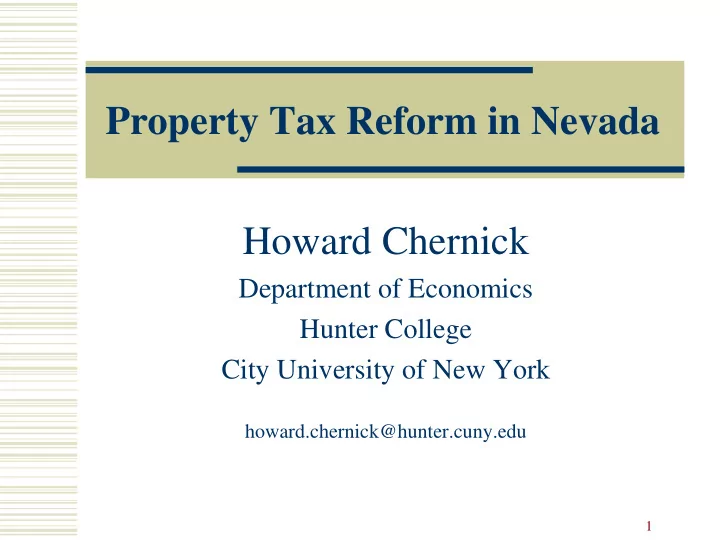

Property Tax Reform in Nevada Howard Chernick Department of Economics Hunter College City University of New York howard.chernick@hunter.cuny.edu 1
Lessons from California � Proposition 13 – passed by voter initiative in 1978 � Rolled back assessments by three years � Lowered maximum effective tax rate to 1% of market value � Increases in assessed value limited to 2% per year � When property sold, reassessed at market value 2
Consequences of Proposition 13 ( after 26 Years) � Positive consequences � Lowered property tax bills � Limits growth in individual property tax bills � Provides predictability about future property tax bills 3
Consequences of Proposition 13 ( after 26 Years) (cont.) � Negative consequences � Limits local government revenues � Limits freedom of local government to choose level of revenue (and hence spending) � County government property tax revenue fixed � State government largely determines local spending 4
Consequences of Proposition 13 ( after 26 Years) (cont.) � Negative consequences � Reassessment at acquisition creates large horizontal inequities among owners of similar properties � Why should newcomers pay higher property taxes? � Less mobile households are favored � A real life example: investor Warren Buffet 5
Impacts of Proposition 13 Warren Buffet Example � The investor Warren Buffet owns two homes in Laguna Beach, CA: � Home 1 – Purchased in mid 1970s, current market value = $4 million; 2003 property tax bill = $2,264. Effective rate is 0.056%. � Home 2 – Purchased in mid-1990s, current market value = $2 million; 2003 property tax bill = $12,250. Effective rate is 0.613% � Effective tax rate on home 2 is 11 times the rate on home 1. 6
Consequences of Proposition 13 ( after 26 Years) (cont.) � More negative consequences � Large variation in the ratio of the market value to assessed value of commercial-industrial property � In LA County in 2002, some existing commercial property valued at 10 times its assessed value � Discriminates against new businesses � Has an anti-competitive effect 7
Consequences of Proposition 13 ( after 26 Years) (cont.) � More negative consequences � Creates an incentive not to move � slows housing adjustment to changes in families’ circumstances � Creates incentives for local governments to approve new commercial development, e.g. strip malls � Has led to the under-funding of cities. They must rely much more heavily on user fees � Local governments use of developer fees has grown � There have been many legal complications 8
Impact of Assessment Cap � Assessment cap will limit local government revenues � There will be increased pressure to expand state sales taxes � Assessment cap favors properties which are appreciating most rapidly � Property tax regressivity will increase if higher value properties appreciate faster. Assessment ratios will be reduced for these properties 9
Property Tax Relief in New York � Large homestead exemption � Exempts first $X thousand from property taxation, thus provides larger tax break to owners of low- value properties � Larger exemptions available to elderly taxpayers with incomes below $60,000 � Larger exemption in wealthier counties, resulting in more regressive tax relief system � State government compensates local governments for lost property tax revenue 10
Property Tax Relief in New York (cont.) � In NYC assessment increases are phased in � Assessment changes for commercial property fully phased in over 5 years � Increase in residential assessment capped at 6% per year and no more than 20% over 5 years � Some increase in value is permanently lost � Leads to higher effective rates in poorer neighborhoods 11
Recommend
More recommend